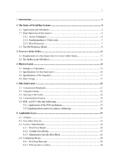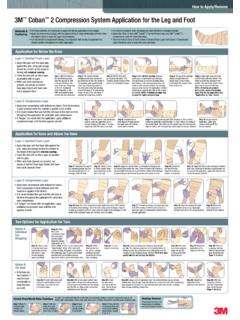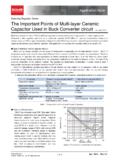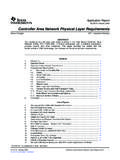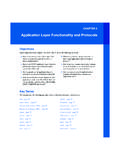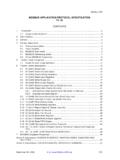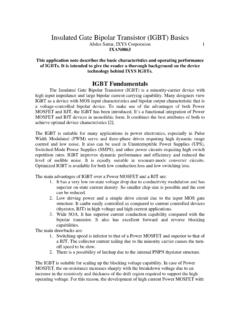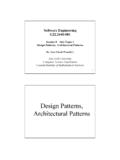Transcription of Dedicated Application Layer (M-Bus)
1 Application Layer M-Bus Page 1 of Application Layer (M-Bus)ForewordThis document has been prepared by the WG4 of CEN TC document is a working : This standard is a backward compatible enhancement to EN1434-3 and is interoperable with IntroductionThe bus communication system of EN1434-3 is commonly called M-Bus. Its Application Layer describesa standard especially for meter readout. It can be used with various physical layers and with link layersand network layers which support the transmission of variable length binary transparent first byte of an Application Layer telegram is the CI-field (Control Information) which distinguishesbetween various telegram types and Application functions. It is also used to distinguish between trueapplication Layer communication and management commands for lower layers.
2 The meaning of theremaining bytes of the telegram depends also on the value of the CI-field. This second revision is acompatible enhancement of the sections to of the original standard EN1434-part 3 some clarifications and implementation hints it contains optional enhancements especially forcomplex meters. Due to technical progress some variants (Fixed format and mode 2=high byte first)are no longer supported in this that this standard contains only directions how data should be coded. It is beyond the task of anapplication Layer standard to define which data must be transmitted under what conditions by whichtypes of slaves or which data transmitted to a slave must have which reactions. Therefore adherenceto this standard guarantees the coexistence and common communication and readout capability ofslaves via a universal master software (covering all optional features), but not yet functional orcommunication interchangeabilty of meters following this standard.
3 For several meter types and meterclasses the company Fernw rme Wien and the AGFW -group of remote heating users haveprovided such Application descriptions required for full interchangeability. They are accessible via thewww-server of the m-bus users group ( ).2. OverviewThe original EN1434-3 defined two possible data sequences in multibyte records. This standard supports only themode where the least significant byte of a multibyte record is transmitted Application Layer M-Bus Page 2 of 4849 Application00h-4 Fhreserved for DLMS-based applications50happlication reset51hdata send (master to slave)52hselection of slaves53hreserved54h-58hreserved for DLMS-based applications55h-5 Bhreserved5 Chsynchronize action60h-6 Fhreserved70hslave to master: report of Application errors71hslave to master: report of alarms72hslave to master: 12 byte header followed by variableformat data73h-77hreserved78hslave to master: Variable data format response withoutheader79hReserved7 Ahslave to master.
4 4 byte header followed by Variabledata format response7Bh-80hreserved81hReserved for a future CEN-TC294- Radio relaying andapplication Layer82hReserved for a future CENELEC-TC205network/ Application Layer82h-8 Fhreserved90h-97hmanufacturer specific (obsolete)A0h-AFhmanufacturer specificB0-B7hmanufacturer specificB8hset baudrate to 300 baudB9hset baudrate to 600 baudBAhset baudrate to 1200 baudBBhset baudrate to 2400 baudBChset baudrate to 4800 baudBDhset baudrate to 9600 baudBEhset baudrate to 19200 baudBFhset baudrate to 38400 baudC0h-FFhreservedTable 11 CI-Field codes used by the Application Layer M-Bus Page 3 of 4849 Note that the CI-codes 50h, 52h, 5Ch, 70h, 71h, 78h, 7Ah, 80h, 81h, A0h-AFh and B8h-BFh are optionalcompatible enhancements of the original standard.
5 Note also that even if the functions of these optional CI-codesare not implemented in a slave the link Layer protocol requires a proper link Layer acknowledge of SND_UDtelegrams containing any of these Application reset (CI = 50h), (optional)With the CI-Code 50h the master can release a reset of the Application Layer in the slaves. Each slave himselfdecides which parameters to change - which data output is default - after it has received such an applicationreset. This Application reset by a SND_UD with CI=50h is the counterpart to the reset of the data link Layer by Application reset subcode (optional)It is allowed to use optional parameters after CI = 50h. If more bytes follow, the first byte is the Application resetsubcode. Further bytes are ignored. The Application reset subcode defines which telegram function and whichsubtelegram is requested by the master.
6 The datatype of this parameter is 8 bit binary. The upper 4 bits define thetelegram type or telegram Application and the lower 4 bits define the number of the subtelegram. The lower fourbits may me ignored for slaves which provide only a single telegram for each Application . The use of the valuezero for the number of the subtelegram means that all telegrams are with only one type of telegram may ignore Application reset and the added parameters but have to confirmit (E5h).The following codes can be used for the upper 4 bits of the first parameter:CodingDescriptionExamples0000b All0001bUser dataconsumption0010bSimple billingactual and fixed date values+dates0011bEnhanced billinghistoric values0100bMulti tariff billing0101bInstaneous valuesfor regulation0110bLoad management values for management0111bReserved1000bInstallation and startupbus adress, fixed dates1001bTestinghigh resolution values1010bCalibration1011bManufacturing 1100bDevelopment1101bSelftest1110bReserv ed1111bReservedTable 22 Coding of the upper four bits of the first parameter after CI = Application Layer M-Bus Page 4 of 4849 Note that this table has been expanded with optional elements from the original Master to slave data send (51h) (optional)The CI-Field code 51h is used to indicate the data send from master to slave.
7 Variable Data Blocks (Records)MDH(opt) datavariable number1 Bytevariable numberFig. 1 Variable Data Structure master to slaveNote that this structure is identical to the slave to master direction (see chapter 4) with the exception of the fixedheader which is omitted in this Slave select (52h) (optional)The CI-Field code 52h is used for the management of the optional secondary addressing (See chapter 9). action (CI = 5Ch) (optional)This CI-code can be used for synchronizing functions in slaves and masters ( clock synchronization). Specialactions or parameter loads may be prepared but their final execution is delayed until the reception of such aspecial CI-field of Application errors (slave to master) (CI = 70h) (optional)For details of the report of Application errors see chapter of alarm status (slave to master) (CI = 71h) (optional)For details of the report of alarm status errors see appendix data respond (slave to master) (CI = 72h, 78h, 7Ah)For details see chapter switch commands B8h-BFh (optional)These optional commands can be used by a master to switch the baudrate of a details see chapter Application Layer M-Bus Page 5 of 48493 Variable data respond (CI=72h, CI=78h, CI=7Ah)
8 Data Header of variable data respond The CI-Field codes 72h, 78h, 7Ah are used to indicate the variable datastructure in long frames (RSP_UD) with optional fixed header. Note that the CI-fields 78h and 7Ah are extensionsfrom the EN1434-3. They are recommended for new master implementations to simplify the integration of radiobased 2 shows the way this data is Header(Req.)Variable Data Blocks (Records)MDH(opt) dataOpt)0 byte (CI=78h)4 byte (CI=7Ah)12 byte (CI=72h)variable number1 Bytevariable numberFig. 2 Variable Data Structure in Answer Structure of Data Header (CI=72h)The first twelve bytes of the user data consist of a block with a fixed length and structure (see fig. 3).Ident. typeAccess Byte2 Byte1 Byte1 Byte1 Byte1 Byte2 ByteFig. 3 Data Header CI= Structure of Data Header (CI=7Ah)The first four bytes of the user data consist of a block with a fixed length and structure (see fig.
9 4).This CI-field is proposed for systems using the future physical and link Layer standardfor radio communication. Inthis standard the link Layer adress contains the information fields of the manufacturer, the device type, the versionand the identification number, so that these 8 bytes from the fixed header of the CI=72h are not required in theapplication Layer part of a Byte1 Byte2 Application Layer M-Bus Page 6 of 4849 Fig. 4 Data Header CI= Identification numberThe Identification Number is either a fixed fabrication number or a number changeable by the customer, codedwith 8 BCD packed digits (4 Byte), and which thus runs from 00000000 to 99999999. It can be preset at fabricationtime with a unique number, but could be changeable afterwards, especially if in addition an unique and notchangeable fabrication number (DIF = 0Ch, VIF = 78h, see chapter ) is Manufacturer identificationThe field manufacturer is coded unsigned binary with 2 bytes.
10 This manufacturer ID is calculated from the ASCII code of EN 61107 manufacturer ID (three uppercase letters) with the following formula:Man. ID =[ASCII(1st letter)- 64] 32 32+[ASCII(2nd letter)- 64] 32+[ASCII(3rd letter)- 64]Note that currently the flag association administers these three letter manufacturers ID of Version identificationThe field version specifies the generation or version of the meter and depends on the manufacturer. It can beused to make sure, that within each version number the identification # is Device type identificationThe devicebyte is coded as follows:Device type (previously called medium)Code 7 .. 0 Code 000000 Oil0000 000101 Electricity0000 001002 Gas0000 001103 Heat0000 010004 Steam0000 010105 Warm Water (30 C-90 C)0000 011006 Water0000 Application Layer M-Bus Page 7 of 4849 Heat Cost 100008 Compressed Air0000 100109 Cooling load meter (Volume measured at return temperature:outlet)0000 10100 ACooling load meter (Volume measured at flow temperature: inlet)0000 10110 BHeat (Volume measured at flow temperature: inlet)0000 11000 CHeat / Cooling load meter0000 1101 ODBus / System component0000 11100 EUnknown Medium0000 to 14 Hot water (>=90 C)0001 010115 Cold Water0001 011016 Dual register (hot/cold) Water meter (See note 1)0001 011117 Pressure0001 100018A/D Converter0001 toFFhTable 3 Device type identificationNote 1.
